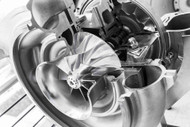How Turbochargers Work and Boost Your Engine | Truck Parts
Sep 26th 2023
In the world of automotive engineering, few components have revolutionized engine performance quite like turbochargers. These ingenious devices are found in a wide range of vehicles, from sports cars to commercial trucks, and they play a pivotal role in extracting every ounce of power from an engine. In this comprehensive guide, we will delve deep into the fascinating world of turbochargers, exploring their inner workings, the science behind them, and the remarkable benefits they bring to the table.
The Basics of Turbocharging
What Is a Turbocharger?
A turbocharger, often simply referred to as a "turbo," is a mechanical device that enhances an engine's performance by forcing more air into its combustion chambers. This extra air, along with the appropriate amount of fuel, results in a more potent combustion process and, subsequently, increased power output.
The Concept of Forced Induction
Turbocharging falls under the category of forced induction, which involves compressing the incoming air to boost its density before it enters the engine. This compressed air allows for the efficient combustion of more fuel, translating into higher horsepower and torque figures.
Turbocharger Components
Turbine Wheel
At the heart of a turbocharger lies the turbine wheel, positioned in the exhaust stream. It spins rapidly, driven by the flow of hot exhaust gases, and is the initial component responsible for harnessing wasted energy.
Compressor Wheel
On the other end of the turbocharger, the compressor wheel is connected to the same shaft as the turbine wheel. As the turbine wheel spins, it powers the compressor wheel, which pressurizes incoming air before it enters the engine.
Bearing Housing and Seals
Turbochargers feature bearing housings and seals that help reduce friction and ensure the longevity of the turbo's rotating components. These components are typically lubricated by engine oil.
The Turbocharging Process
Exhaust Gas Energy Conversion
The magic of turbocharging begins with the flow of hot exhaust gases from the engine into the turbine housing. These gases contain a significant amount of energy, which is transformed into kinetic energy when they flow over the curved blades of the turbine wheel.
Spinning the Compressor Wheel
The high-speed rotation of the turbine wheel is transmitted through a common shaft to the compressor wheel, which draws in ambient air and compresses it before delivering it to the engine's intake manifold.
The Role of the Intercooler
To ensure the compressed air remains at an ideal temperature, many turbocharged engines incorporate an intercooler. This component cools the air, making it denser and more oxygen-rich, further enhancing combustion efficiency.
Benefits of Turbocharging
Enhanced Power and Torque
Perhaps the most significant advantage of turbocharging is the substantial boost in power and torque. Smaller, turbocharged engines can deliver performance on par with larger naturally aspirated engines.
Improved Fuel Efficiency
Turbochargers not only increase power but also improve fuel efficiency, especially at lower engine loads. Smaller engines operating efficiently can save fuel and reduce emissions.
Environmental Benefits
By allowing manufacturers to downsize engines without sacrificing performance, turbocharging contributes to reducing the carbon footprint of vehicles. This smaller engine displacement results in fewer emissions during daily driving.
The Challenges of Turbocharging
Heat and Stress
Turbochargers generate significant heat and expose the engine to added stress. This can lead to increased wear and tear on engine components, necessitating rigorous maintenance schedules.
Turbo Lag
One common challenge associated with turbochargers is turbo lag—the delay between the driver's throttle input and the turbocharger reaching full boost. Advanced technologies like twin-scroll turbos and electric turbos are employed to mitigate this issue.
Turbocharging in Various Applications
Sports Cars
High-performance sports cars often feature turbochargers to deliver exhilarating acceleration and top speeds. Turbocharging allows manufacturers to achieve impressive power-to-weight ratios.
Passenger Vehicles
Even everyday passenger vehicles benefit from turbocharging. Smaller, turbocharged engines offer improved fuel economy without sacrificing performance, making them popular in compact cars and SUVs.
Commercial Trucks
In the world of commercial transportation, turbochargers are essential. They enable trucks to haul heavy loads efficiently, climb steep inclines, and navigate challenging terrain.
Future of Turbocharging
Electrification and Hybridization
As the automotive industry shifts toward electrification and hybridization, turbochargers are expected to play a crucial role. Electric turbos can provide instant power when needed, working in tandem with electric motors to boost performance.
Improved Efficiency
Ongoing research and development are focused on making turbochargers even more efficient. This includes advancements in materials, aerodynamics, and electronic controls to maximize power delivery while minimizing drawbacks.
Turbochargers have revolutionized the automotive world, delivering exhilarating performance, improved fuel efficiency, and reduced emissions. These remarkable devices continue to evolve, pushing the boundaries of what's possible in engine technology. Whether you're behind the wheel of a sports car, a daily driver, or a commercial truck, turbocharging has left an indelible mark on the way we experience the open road. As the industry looks toward a future of electrification and hybridization, turbochargers will remain a vital component in shaping the vehicles of tomorrow.

 US Dollars
US Dollars
